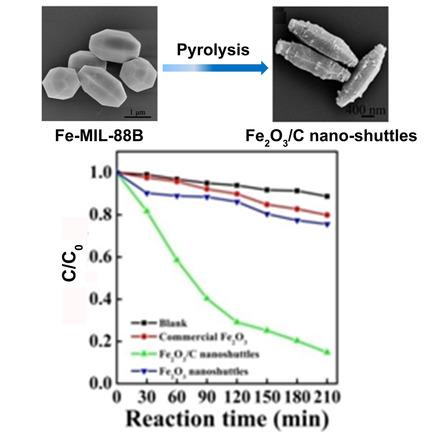当前位置:
X-MOL 学术
›
ChemistrySelect
›
论文详情
Our official English website, www.x-mol.net, welcomes your
feedback! (Note: you will need to create a separate account there.)
Metal‐Organic Framework Derived Porous α‐Fe2O3/C Nano‐shuttles for Enhanced Visible‐light Photocatalysis
ChemistrySelect ( IF 1.9 ) Pub Date : 2020-01-20 , DOI: 10.1002/slct.201904021 Yingping Pang 1 , Zhengping Li 2 , Xiuling Jiao 1 , Dairong Chen 1 , Cheng Li 1
ChemistrySelect ( IF 1.9 ) Pub Date : 2020-01-20 , DOI: 10.1002/slct.201904021 Yingping Pang 1 , Zhengping Li 2 , Xiuling Jiao 1 , Dairong Chen 1 , Cheng Li 1
Affiliation

|
Visible‐light photocatalytic degradation is one of the most intriguing and cost‐effective strategy toward wastewater treatment, wherein one key lies in the design of efficient photocatalysts that afford fast migration of photo‐generated electrons and holes on the interfaces to react with the pollutants. In this article, a rational design of photocatalyst by controlled pyrolyzing Fe‐MIL‐88B MOF precursor was described for the synthesis of porous α‐Fe2O3/C nano‐shuttles. These nano‐shuttles are very uniform with a length of ∼1.5 μm and width of ∼500 nm, with each one consisting of subunit nanocrystals and interstitial nanopores produced thereby. This unique structure plays an important role in improving photocatalytic activity by increasing the surface area of the material and enhancing the adsorption of the dye molecules. Moreover, this MOF‐derived α‐Fe2O3/C composite can quickly transfer light‐generated electrons to prevent recombination between photo‐generated electrons and holes, thereby increasing the photo‐carrier concentration, and thus the photocatalytic efficiency can be significantly improved. The results show that methylene blue (MB) degradation rate reaches 85.2% in 210 min under simulated sunlight illumination using porous α‐Fe2O3/C nano‐shuttle photocatalyst, which is much higher than that of Fe‐MIL‐88B (39.1%), commercial α‐Fe2O3 (20%) and pure α‐Fe2O3 nano‐shuttles (24.4%).
中文翻译:

金属有机骨架衍生的多孔α-Fe2O3/ C纳米穿梭增强可见光的光催化作用
可见光光催化降解是废水处理中最引人入胜且最具成本效益的策略之一,其中关键在于高效光催化剂的设计,该催化剂能够使光生电子和界面上的空穴快速迁移,从而与污染物发生反应。在本文中,通过控制热解的Fe-MIL-88B MOF前体光催化剂的合理设计为多孔的合成被描述的α-Fe 2 ö 3/ C纳米梭。这些纳米梭非常均匀,长度约1.5μm,宽度约500 nm,每个都由亚单位纳米晶体和由此产生的间隙纳米孔组成。通过增加材料的表面积并增强染料分子的吸附,这种独特的结构在改善光催化活性方面起着重要作用。此外,该MOF衍生的α-Fe 2 ö 3/ C复合材料可以快速转移光生电子,从而防止光生电子与空穴复合,从而增加了光载流子浓度,从而可以显着提高光催化效率。结果表明,亚甲基蓝(MB)的降解速率使用多孔在210分钟达到85.2%下模拟太阳光照射的α-Fe 2 ö 3 / C纳米梭光催化剂,其比的Fe-MIL-88B的高得多(39.1 %),商业的α-Fe 2 ö 3(20%)和纯的α-Fe 2 ö 3纳米梭(24.4%)。
更新日期:2020-01-21
中文翻译:

金属有机骨架衍生的多孔α-Fe2O3/ C纳米穿梭增强可见光的光催化作用
可见光光催化降解是废水处理中最引人入胜且最具成本效益的策略之一,其中关键在于高效光催化剂的设计,该催化剂能够使光生电子和界面上的空穴快速迁移,从而与污染物发生反应。在本文中,通过控制热解的Fe-MIL-88B MOF前体光催化剂的合理设计为多孔的合成被描述的α-Fe 2 ö 3/ C纳米梭。这些纳米梭非常均匀,长度约1.5μm,宽度约500 nm,每个都由亚单位纳米晶体和由此产生的间隙纳米孔组成。通过增加材料的表面积并增强染料分子的吸附,这种独特的结构在改善光催化活性方面起着重要作用。此外,该MOF衍生的α-Fe 2 ö 3/ C复合材料可以快速转移光生电子,从而防止光生电子与空穴复合,从而增加了光载流子浓度,从而可以显着提高光催化效率。结果表明,亚甲基蓝(MB)的降解速率使用多孔在210分钟达到85.2%下模拟太阳光照射的α-Fe 2 ö 3 / C纳米梭光催化剂,其比的Fe-MIL-88B的高得多(39.1 %),商业的α-Fe 2 ö 3(20%)和纯的α-Fe 2 ö 3纳米梭(24.4%)。

































 京公网安备 11010802027423号
京公网安备 11010802027423号